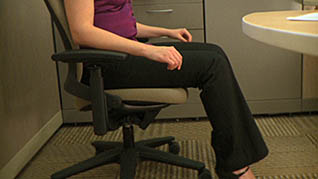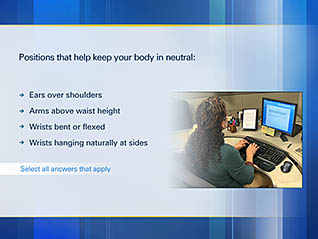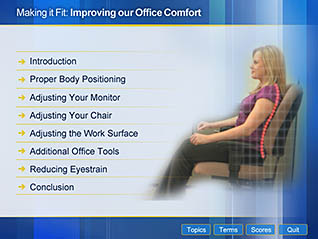Ergonomics: Office Ergonomics: Improving our Office Comfort
- Product ID
- clmioerg
- Training Time ?
- 53 to 106 minutes
- Language(s)
- English
- Video Format
- High Definition
- Required Plugins
- MasteryNet Player
- Lesson Interactions
- 13
- Quiz Questions
- 27
- Closed Captioning



It may surprise you the toll desk work can take on your body. This training video stresses the importance of maintaining a neutral body position to ensure proper posture and reduce muscle strain from a typical day at the office.
This high-definition video training explains how to sit properly, how to adjust the chair back, seat pan, arm rests and height to support the natural curve of the spine. Placement of the computer monitor to lessen eye strain is explained, as is eliminating indirect and direct glare. Ways to adjust the work surfaces in the office to facilitate proper body positioning are discussed. Emphasis is given to proper keyboard positioning and mouse selection and use. Tools to make an office workers' life easier, such as wired or cordless telephone headsets, and document holders are explained. Viewers learn several easy exercises to perform at their desks to alleviate muscle strain and fatigue, particularly in the forearms, neck, shoulders and lower back.
A quick quiz follows each section of training to ensure viewers understand the main points. This video training makes the science of ergonomics easy to understand and even easier to implement.
![]() This course is in the Advantage™ format, to read about Advantage™ features click here.
This course is in the Advantage™ format, to read about Advantage™ features click here.

- Rich multimedia presentation with interactions and quiz
- Print certificate and wallet card
- You have 30 days to complete the course
All office workers
-
Proper Body Positioning
- Maintaining neutral body position
- Changing positions
- Stretches
-
Adjusting Your Monitor
- The body follows the eyes
- Monitor placement
- Direct and reflected glare
- Distance from the monitor
- Monitor adjustments
- Using bifocals, trifocals or reading glasses
-
Adjusting Your Chair
- Four key adjustments
- Seat height
- Seat depth
- Chair back
- Arm rests
-
Adjusting the Work Surface
- Benefits of a properly adjusted work surface
- Various work surfaces
-
Additional Office Tools
- Keyboard designs and accessories
- Pointing devices
- Document holders
- Telephone aids
-
Reducing Eyestrain
- Eye strain
- Wearing glasses
- Exercises for dry eyes
-
Maintain proper body positions to reduce the potential for injury.
- Recognize the benefits of maintaining your body in neutral position.
- Select proper positions when the body is in neutral.
- Recall how often you should change positions when working in a stationary position.
-
Perform periodic stretches when working in a stationary position.
- Identify the type of stretch that helps reduce tightness in the forearms.
- Choose exercises which help reduce tension and tightness in the neck and shoulders.
-
Adjust your monitor to create an ergonomically correct work environment.
- Agree that your eyes lead your body into its working position.
- Select proper monitor placement to reduce neck and shoulder strain.
- Recall that both direct and reflected glare can cause the eyes to ti
- Agree that generally, the closer you are to the monitor the harder it is for your eyes to focus.
- Choose ways to minimize eyestrain.
- Identify the proper screen adjustment when wearing bifocals, trifocals or reading glasses.
-
Properly adjust your chair to work comfortably.
- List the four key areas to focus on when adjusting your work chair.
- Identify the proper body position when your seat is at the proper height.
- State the benefit of proper seat depth.
- Recall how to test proper seat depth.
- Agree that the curve of the chair back needs to support the inward curve of the low back.
- Select best practices to prevent discomfort when using a chair with armrests.
-
Properly adjust work surfaces.
- Explain the benefit of a properly adjusted work surface.
- Agree to keep your body in neutral when adjusting your work surface.
-
Utilize various office tools to eliminate stress and strain.
- Choose keyboard adjustments that help ensure proper hand positioning.
- Agree that there are both right and left mouse devices.
- Select the benefits of using a document holder.
- Explain the benefits of using a telephone headset.
-
Reduce eyestrain when working with computers.
- Identify the percentage of computer users who experience eyestrain.
- Agree you should avoid locking your head and neck when using multiple correction lenses.
- Explain how to alleviate dry eyes.
© Mastery Technologies, Inc.




